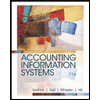
(1)
Financial Accounting Standards Board (FASB): FASB is an independent 7 member board, of accounting professionals overseeing the creation of financial statement. FASB standards are generally known as GAAP.
Generally Accepted Accounting Principle (GAAP): Generally Accepted Accounting Principle (GAAP) is a common set of accounting principles, standards, and procedures that the companies must follow at the time of preparation of the financial statements.
To Explain: The desired benefits from revising an accounting standard.
(2)
To Explain: The possible costs that could arise from revision of accounting standard.
(3)
To Explain: The steps to be taken by FASB to assess possible benefits and costs that could arise from revision of accounting standard.
Want to see the full answer?
Check out a sample textbook solution
Chapter 1 Solutions
Intermediate Accounting
 Accounting Information SystemsFinanceISBN:9781337552127Author:Ulric J. Gelinas, Richard B. Dull, Patrick Wheeler, Mary Callahan HillPublisher:Cengage Learning
Accounting Information SystemsFinanceISBN:9781337552127Author:Ulric J. Gelinas, Richard B. Dull, Patrick Wheeler, Mary Callahan HillPublisher:Cengage Learning Financial & Managerial AccountingAccountingISBN:9781285866307Author:Carl Warren, James M. Reeve, Jonathan DuchacPublisher:Cengage Learning
Financial & Managerial AccountingAccountingISBN:9781285866307Author:Carl Warren, James M. Reeve, Jonathan DuchacPublisher:Cengage Learning Financial & Managerial AccountingAccountingISBN:9781337119207Author:Carl Warren, James M. Reeve, Jonathan DuchacPublisher:Cengage Learning
Financial & Managerial AccountingAccountingISBN:9781337119207Author:Carl Warren, James M. Reeve, Jonathan DuchacPublisher:Cengage Learning




